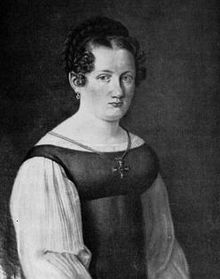Charlotte von Siebold
This article has multiple issues. Please help improve it or discuss these issues on the talk page. (Learn how and when to remove these template messages)
|

Marian Theodore Charlotte Heidenreich von Siebold (12 September 1788 – 8 July 1859) was a German physician.[1] She is regarded as the first gynecologist in Germany. She was the daughter of the physicians Damian and Regina von Siebold and was an early assistant of her parents. She graduated with a degree in obstetrics at the Giessen University in 1817.
She assisted at both Queen Victoria's birth on 24 May 1819 at Kensington Palace in London and Queen Victoria's first cousin and husband Prince Albert of Saxe-Coburg and Gotha's birth on 26 August 1819 at Rosenau Palace near Coburg.
Life[edit]
Origin and education[edit]
Charlotte was the first child of Georg Heiland Government Council and his wife (Regina) Josepha. After Georg Heiland’s death, Josepha Heiland (Johann Theodor) Damian of Siebold (1769-1828) married the city doctor and medical officer of Darmstadt from Göttingen, known as the “Starstich” surgeon, and son of Carl Caspar von Siebold. [2]
Damian of Siebold adopted Charlotte and her sister Therese, with both receiving his surname. To improve the family income, Josepha von Siebold worked in her husband’s practice. Later, she even studied medicine and received the 'Ehrendoktorwürde der Entbindungskunst, an honourary doctorate of childbirth, in 1815.
Charlotte was interested in medicine and read her father’s books on Anatomy and physiology. She later received theoretical instruction from her father and practical training from her mother, but the focus was on obstetrics. In 1811 Charlotte went to Göttingen to attend private lectures by Osiander and Langenbeck.[3]
In 1814, Charlotte passed the exam for obstetrics before the “Grand Duchy of Hessen Grand-Ducal Medicinal-Collegium” in Darmstadt and was allowed to practise as an obstetrician from then on. On 26 March 1817, she became a „Doktorin der Geburtshilfe“, a ‘doctor of obstetrics’ with the thesis work titled ‘Using pregnancy outside the cervical and abdominal pregnancies in particular’.
Work[edit]
Charlotte vonSiebold moved back to Darmstadt and worked there in her parents’ maternity hospital. She taught midwives and took care of the poor as well as raised money for the ‘Buergerhospital’ of Darmstadtl. In 1829, she married the military doctor August Heidenreich (1801-1880) who was 14 years her junior and who later became Generalstabsarzt, the chief medical doctor of the armed forces. In 1845, she set up an obstetric facility for the poor in Darmstadt.
Charlotte von Siebold, enjoyed an excellent reputation as a childbirth assistant and was called several times to give births to multiple royal courts. She helped both Victoire, Duchess of Kent, the mother of the later Königin Victoria, and the DuchessLuise Sachsen-Coburg and Gotha, the mother of the later husband of Queen Victoria, Prinzgemahl Albert of Sachsen-Coburg and Gotha-Albert, during the births of their respective children. [4]
Tribute[edit]
On 9 June 1854, the birthday Grand Duke Ludwigs III of Hessen and near Rhine, she was the only woman to be awarded the Knight Cross of the Order of Merit of Philipps the magnanimous. In Darmstadt, the Heidenreichstraße is named after her. Founded after her death in Darmstadt, the Heidenreich-von Sieboldsche Stiftung zur Unterstützung von armen Wöchnerinnen was later transformed into Darmstädter Stiftung für Wohltätigkeitszwecke’. Since 2006, the Medical Faculty of the University of Göttingen has launched the ‘Heidenreich von Siebold Programm’ to support female scientists.[5]
The Charlotte Heidenreich von Siebold Prize, named after her, is awarded every two years by the Entega Foundation. [6]
Notes[edit]
- ^ Ulrike Enke: Geburtshelferin der englischen Königin. In: Hessisches Ärzteblatt. 8, 2009, ISSN 0171-9661, S. 525–526, Volltext (PDF; 185 kB).
- ^ Vgl. auch Andreas Mettenleiter: Das Juliusspital in Würzburg. Band III: Medizingeschichte. Herausgegeben vom Oberpflegeamt der Stiftung Juliusspital Würzburg anlässlich der 425jährigen Wiederkehr der Grundsteinlegung. Stiftung Juliusspital Würzburg (Druck: Bonitas-Bauer), Würzburg 2001, ISBN 3-933964-04-0, S. 105.
- ^ Ulrike Enke: ‘Birth assistant of the English Queen’, in: ‘Hessisches Ärzteblatt’, 8, 2009, ISSN|0171-9661 die, pp. 525–526, envoyWebarchiv |url=http://www.laekh.de/upload/Hess._Aerzteblatt/2009/2009_08/2009_08_10.pdf |text= Full text (PDF; 185 kB) |wayback=20150212030030ľ.
- ^ Jost Benedum, Christian Giese (eds.): “375 years of medicine in Gießen. An image and text documentation of 1607-1982." Gießen 1983, pp. 115 et seq.
- ^ University Medicine Göttingen
- ^ awards in Darmstadt
Sources[edit]
- Ulrike Enke: Geburtshelferin der englischen Königin. In: Hessisches Ärzteblatt. 8, 2009, ISSN 0171-9661, S. 525–526, Volltext (PDF; 185 kB).


 French
French Deutsch
Deutsch